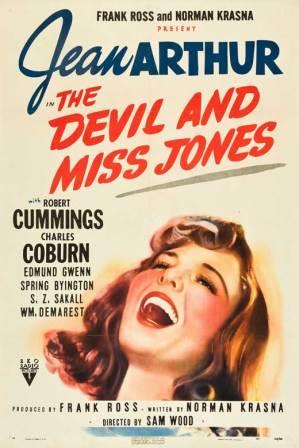A neglected little masterpiece full of charm and good humor.
You would be in good company with many of the characters in this little comedy, The Devil and Miss Jones. The head of the shoe division in Neeley’s department store, named, simply enough, Mary Jones (Jean Arthur), is a tower of strength, offering advice and encouragement to all. Her boyfriend, Joe O’Brien (Robert Cummings), recently fired from the store, is a labor union organizer often in need of reassurance. A darlingly sweet clerk, Elizabeth (Spring Byington, in a soft, unfussy role this time, for a change) is at the forefront in converting one of the villains in our little story.
The first of these, whom you might not at first like, is J. P. Merrick (Charles Coburn), supposedly the richest man in the world. Among his holdings is Neeley’s department store, where he poses as just another clerk to expose agitators and fire incompetents, or those who simply offend him. For those due a comeuppance, he records their names in his little “doomsday” pocket notepad.
The second villain, unredeemable as it will prove and who is Merrick’s first notepad entry to be fired, is the nasty shoe department section manager, known frostily only as “Mr. Hooper” (Edmund Gwenn, cast against his usual type of affability and benevolence).
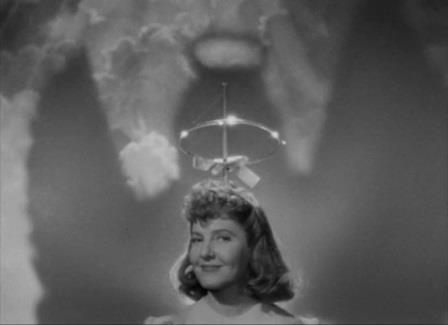 Although The Devil and Miss Jones is an RKO film, the main title opens like a Universal movie, with Coburn, a scowl on his face and surrounded by flames, obviously the “devil” of the title, with appropriate demonic music by Roy Webb. The camera pans right, to Arthur, her halo and innocent smile accompanied by contrasting angelic music. She looks to her right, spies Coburn and blows heartily, putting out his flames and deepening his scowl.
Although The Devil and Miss Jones is an RKO film, the main title opens like a Universal movie, with Coburn, a scowl on his face and surrounded by flames, obviously the “devil” of the title, with appropriate demonic music by Roy Webb. The camera pans right, to Arthur, her halo and innocent smile accompanied by contrasting angelic music. She looks to her right, spies Coburn and blows heartily, putting out his flames and deepening his scowl.
Producer Frank Ross and screenwriter Norman Krasna (nominated for an Oscar) borrowed $600,000 from the bank to make the The Devil and Miss Jones, the first of two starring Arthur. The second and last film in the short-lived production company was A Lady Takes a Chance (1943), opposite John Wayne.
The Devil and Miss Jones opens as three limousines, viewed from a low camera beneath towering New York skyscrapers, arrive at a stately mansion. A solemn-faced businessman emerges from each of the first two cars and two from the third: Edwin Maxwell (the opera board chairman in Mr. Deeds Goes to Town, 1936), Montagu Love (Henry VIII in The Prince and the Pauper, 1937); Richard Carle (Gaston in Ninotchka, 1939) and Charles Waldron (General Sternwood in The Big Sleep, 1946).
 With portentous music, the large glass doors of the mansion are opened by the butler, George (S. Z. Sakall, Carl in Casablanca, 1942). He leads the quartet of gentlemen into a great hall where they sit nervously and wait . . . and wait.
With portentous music, the large glass doors of the mansion are opened by the butler, George (S. Z. Sakall, Carl in Casablanca, 1942). He leads the quartet of gentlemen into a great hall where they sit nervously and wait . . . and wait.
Presently, J. P. Merrick enters and the four men, clearly yes-men of the first order, mull over a front-page newspaper showing an effigy of their boss during a recent union demonstration.
“I pay you a great deal,” an angry Merrick tells them, “to take care of my interests and my privacy. I want my privacy. I haven’t had my photograph in a newspaper in twenty years.”
After Merrick has abruptly dismissed the men, a detective they have hired, Thomas Higgins (Robert Emmett Keane, Burton in Boys Town, 1938), enters with a scheme to expose the department store culprits—in “two or three weeks,” after his wife has had a baby, of course. Merrick discharges him. He thinks he can assume Higgins’ name and do a better job himself, undercover, in two or three days.
Merrick arrives at work as Thomas Higgins and reports to Hooper, who immediately irritates him. Afterward, Higgins will write in his notepad, “Fire Station Manager.”
 Higgins is assigned to slippers, and is quickly encouraged by Mary, head of the shoe department: “Don’t forget people can always do without slippers. They have to be convinced.”
Higgins is assigned to slippers, and is quickly encouraged by Mary, head of the shoe department: “Don’t forget people can always do without slippers. They have to be convinced.”
He at first refuses to take his lunch hour, because at home he pampers a weak stomach with milk and Graham crackers and carries pepsin-flavored chewing gum in his coat pocket. But upon Mary’s insistence, he takes the hour off, asking to just sit withElizabeth, that he isn’t hungry.
After much persuasion, he reluctantly takes the tuna fish popover she offers him, her own “invention,” she says. After a bite or two, she asks him how he likes it. “I don’t know yet,” he replies. When he finishes the popover, he admits, “Tastes good.”
During the day, an irate young man, Joe O’Brien, handcuffs himself to a heating pipe, protesting the firing of him and other employees who tried to organize and announcing a union meeting that evening. He is hauled away by two store detectives.
Before all the employees, tears in her eyes, Mary gives an emotional testimonial, asking Higgins to stand as an example of how Neeley’s will discard him for a younger man. Higgins looks about, perplexed, irritated and disbelieving. Afterward, Elizabeth purrs, “You were wonderful.” He replies, “I didn’t do anything.”
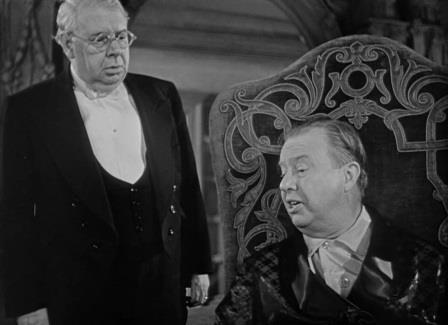 When he returns home after work, he tells George no more Graham crackers: he wants a lunch of tuna fish popovers to take to work next day in a shoe box. When George protests that the chef has never made popovers, Merrick barks, “Then get one who does. If certain people can make them on a little gas strove, then that idiot downstairs ought to be able to make them.”
When he returns home after work, he tells George no more Graham crackers: he wants a lunch of tuna fish popovers to take to work next day in a shoe box. When George protests that the chef has never made popovers, Merrick barks, “Then get one who does. If certain people can make them on a little gas strove, then that idiot downstairs ought to be able to make them.”
Next day, Elizabeth asks Mary to ask Higgins to go with her to Coney Island with Mary and Joe. He agrees when he discovers that Hooper has been taking her out. Higgins brings from his cellar a bottle of his finest wine, label removed, to impress his new-found friends, but they find it awful, preferring the “wine” made by the grandfather of Joe’s iceman, who stomps on the grapes in the bathtub with his feet. “Why didn’t he take his socks off?” Higgins surmises.
In a long sketch, Higgins wanders away from the group in search of the bathhouse where he had exchanged his street clothes for swimming attire. In trying to sell his expensive watch to make a phone call to his chauffeur, he is deemed suspicious by a policeman (Regis Toomey, Sanders in His Girl Friday, 1940) and brought before a police station sergeant (Edward McNamara, another police sergeant in Arsenic and Old Lace, 1944). Joe and Mary arrive shortly. Joe uses his legal knowledge to intimidate the policemen into releasing Higgins.
At the end of the Coney Island visit, Joe gives up on crusading for the employees and discards his list of four hundred names, those who support unionizing. Higgins hands it to Mary, who suggests he keep it.
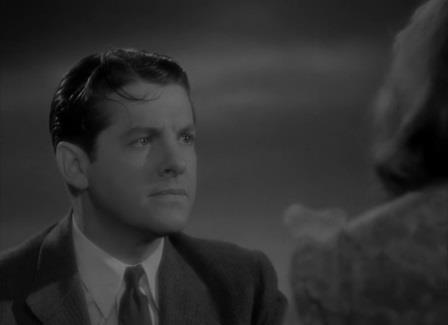 On the return from Coney Island, Mary finds the real Higgins’ business card which the masquerading Higgins accidentally drops, identifying him as a spy for the department store. She tells a stunned Joe, who suggests she “get him” in the store the next day—and retrieve the list of names.
On the return from Coney Island, Mary finds the real Higgins’ business card which the masquerading Higgins accidentally drops, identifying him as a spy for the department store. She tells a stunned Joe, who suggests she “get him” in the store the next day—and retrieve the list of names.
In a comic sequence, Mary finds the heaviest possible shoe in the stock room to use to knock out Higgins, hesitating more than once until she is saved the trouble when a heavy riding boot falls from the top shelf and renders him unconscious.
Higgins is revived and hauled to the store manager, Mr. Allison (Walter Kingsford, Dr. Walter Carew in the Dr. Kildare series, 1937-1947). Higgins speaks up for the employees, which changes Mary’s mind about him. When Allison agrees to concessions if they can prove there are four hundred employees who support unionizing, Higgins produces the list from his coat pocket. Allison reneges and insults Higgins. In a scene worthy of the Marx Brothers, Mary takes a flying leap across Allison’s desk, retrieves the list and she and Higgins run about the office, each eating half the shared list. Joe struggles with Hooper. Mary later commandeers the store intercom and calls for all employees to leave their work and unite in a protest.
From his mansion, Higgins slips unnoticed among the protesters and says he has arranged a meeting between Merrick’s board of governors and representatives of the employees. Still unaware of Higgins’ true identity, Mary, Joe and Elizabeth file into the boardroom with Higgins. The yes-men out-yes themselves in agreeing with Merrick when he supports points made by the workers.
Elizabeth is brought to tears by an insult and leans against Higgins. The board members rush to his aid. “Are you all right, Mr. Merrick?” “Are you hurt, Mr. Merrick?” Stunned by the much-delayed revelation, Elizabeth pulls away, Mary slides down the wall in a scream and Joe faints.
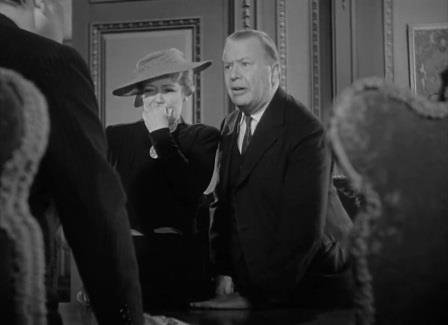 But all is resolved. Next scene, in an ocean liner ballroom, employees and executives dance together, Merrick and Joe with their new brides. And to a chorus of “He’s a Jolly Good Fellow” sung for Merrick, everyone is off to Honolulu.
But all is resolved. Next scene, in an ocean liner ballroom, employees and executives dance together, Merrick and Joe with their new brides. And to a chorus of “He’s a Jolly Good Fellow” sung for Merrick, everyone is off to Honolulu.
The obvious star of The Devil and Miss Jones is Charles Coburn, alternating brilliantly between the wicked Merrick—lovable, somehow, even then—and the strong but affable Higgins. He earned an Oscar nomination for Best Supporting Actor, although he is more than “supporting.” He would win a much-deserved Oscar two years later for The More the Merrier, also with Arthur.
Although Coburn steals the limelight in The Devil and Miss Jones, the others handle their parts well. Jean Arthur is her usual dependable self—did she ever give a weak performance? Robert Cummings’ dramatic limitations as an actor aren’t, by the nature of the comedy, here exposed, and his strongest suit as a light comedian is boyishly displayed. Spring Byington is, as said earlier, “soft” and “sweet.”
